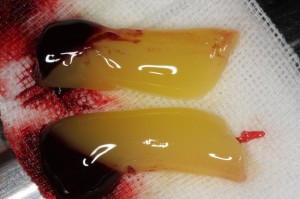Platelet Rich Fibrin not Effective for enhancing Rotator Cuff Surgery
Interesting study last month on the use of a specific type of platelet rich plasma-PRFM (platelet rich fibrin matrix), which is more commonly used in surgery. Instead of a cell suspension, PRFM is more like a dense fibrin clot that has platelets embedded inside. In this study, two groups of shoulder rotator cuff repair patients were studied, one where PRFM was used and the other without-no differences in outcomes between the PMRF and usual group were found in this study. My personal take on the research would be that surgical repair for small and medium sized rotator cuff tears isn’t always recommended (which the study authors commented on by saying PRFM might work for larger tears). Another issue with PRFM is you tend to get an unusually dense fibrin matrix (a very thick and dense clot, different from the soft gel that naturally occurs with a blood clot). This dense matrix is a bit more like fibrin glue. The problem with dense clots (like fibrin glue) is that mesenchymal stem cells have difficulty migrating through the clot, and are more likely to perish. Since MSC’s would be the likely cells stimulated by the platelets to enhance repair, the dense clot of PRFM may have worked against these researchers.

If you have questions or comments about this blog post, please email us at [email protected]
NOTE: This blog post provides general information to help the reader better understand regenerative medicine, musculoskeletal health, and related subjects. All content provided in this blog, website, or any linked materials, including text, graphics, images, patient profiles, outcomes, and information, are not intended and should not be considered or used as a substitute for medical advice, diagnosis, or treatment. Please always consult with a professional and certified healthcare provider to discuss if a treatment is right for you.

